Aboriginal Culture and Discrimination in Canada: A Detailed Analysis
VerifiedAdded on 2023/06/03
|6
|1578
|343
Essay
AI Summary
This essay examines the discrimination faced by Aboriginal communities in Canada, focusing on a racist editorial published by the Morris Mirror newspaper. The essay analyzes the editorial's biased depiction of Aboriginal people as lazy and corrupt, linking it to broader societal prejudices and the historical context of the Idle No More movement. It highlights the importance of addressing systemic racism and promoting tolerance through government policies and responsible journalism. The essay further discusses the cultural significance of land to Aboriginal communities and the ongoing struggle for recognition and rights, emphasizing the need for both the government and the press to actively work towards the well-being and inclusion of Aboriginal people in Canada. Desklib provides access to this essay and many other resources to support students.
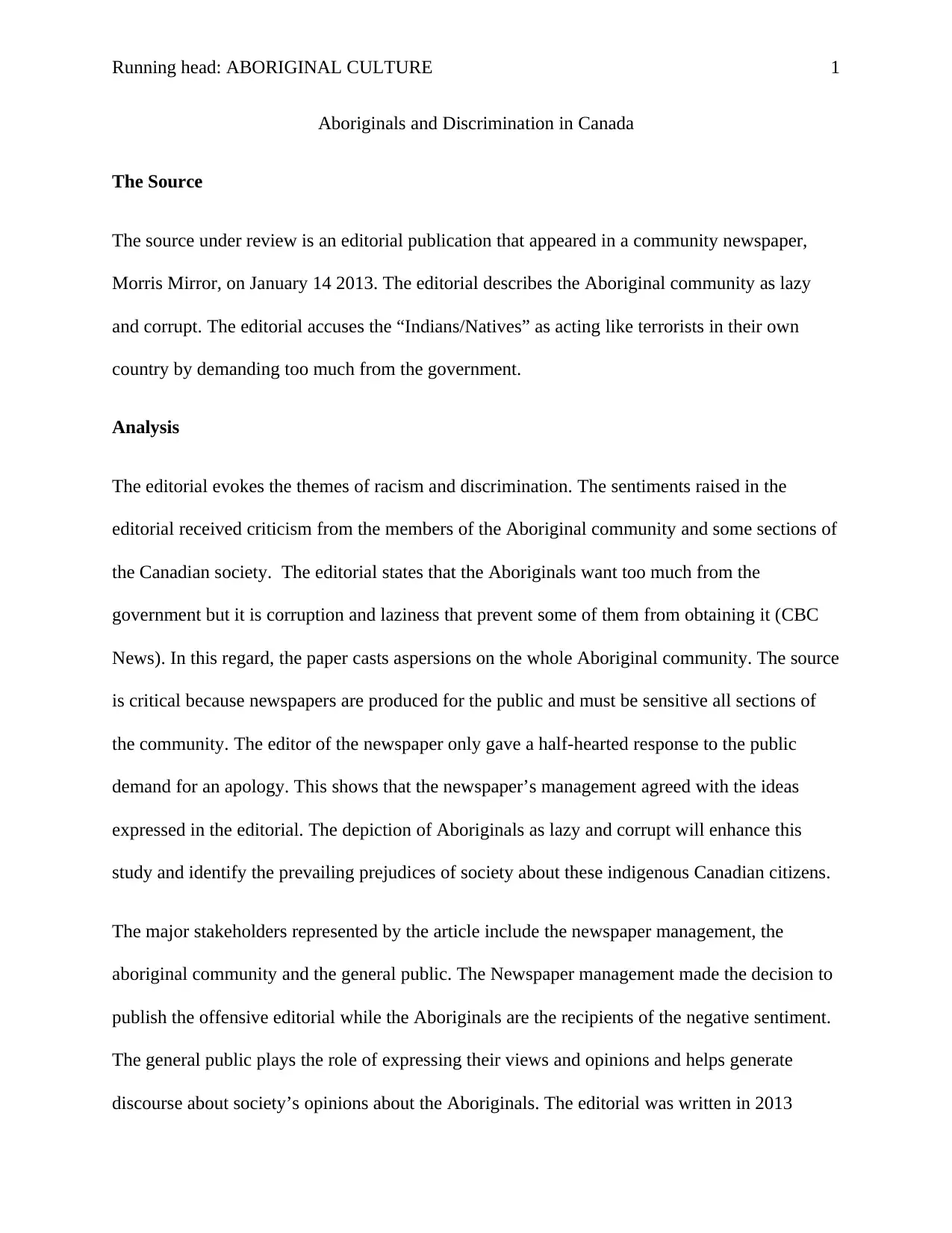
Running head: ABORIGINAL CULTURE 1
Aboriginals and Discrimination in Canada
The Source
The source under review is an editorial publication that appeared in a community newspaper,
Morris Mirror, on January 14 2013. The editorial describes the Aboriginal community as lazy
and corrupt. The editorial accuses the “Indians/Natives” as acting like terrorists in their own
country by demanding too much from the government.
Analysis
The editorial evokes the themes of racism and discrimination. The sentiments raised in the
editorial received criticism from the members of the Aboriginal community and some sections of
the Canadian society. The editorial states that the Aboriginals want too much from the
government but it is corruption and laziness that prevent some of them from obtaining it (CBC
News). In this regard, the paper casts aspersions on the whole Aboriginal community. The source
is critical because newspapers are produced for the public and must be sensitive all sections of
the community. The editor of the newspaper only gave a half-hearted response to the public
demand for an apology. This shows that the newspaper’s management agreed with the ideas
expressed in the editorial. The depiction of Aboriginals as lazy and corrupt will enhance this
study and identify the prevailing prejudices of society about these indigenous Canadian citizens.
The major stakeholders represented by the article include the newspaper management, the
aboriginal community and the general public. The Newspaper management made the decision to
publish the offensive editorial while the Aboriginals are the recipients of the negative sentiment.
The general public plays the role of expressing their views and opinions and helps generate
discourse about society’s opinions about the Aboriginals. The editorial was written in 2013
Aboriginals and Discrimination in Canada
The Source
The source under review is an editorial publication that appeared in a community newspaper,
Morris Mirror, on January 14 2013. The editorial describes the Aboriginal community as lazy
and corrupt. The editorial accuses the “Indians/Natives” as acting like terrorists in their own
country by demanding too much from the government.
Analysis
The editorial evokes the themes of racism and discrimination. The sentiments raised in the
editorial received criticism from the members of the Aboriginal community and some sections of
the Canadian society. The editorial states that the Aboriginals want too much from the
government but it is corruption and laziness that prevent some of them from obtaining it (CBC
News). In this regard, the paper casts aspersions on the whole Aboriginal community. The source
is critical because newspapers are produced for the public and must be sensitive all sections of
the community. The editor of the newspaper only gave a half-hearted response to the public
demand for an apology. This shows that the newspaper’s management agreed with the ideas
expressed in the editorial. The depiction of Aboriginals as lazy and corrupt will enhance this
study and identify the prevailing prejudices of society about these indigenous Canadian citizens.
The major stakeholders represented by the article include the newspaper management, the
aboriginal community and the general public. The Newspaper management made the decision to
publish the offensive editorial while the Aboriginals are the recipients of the negative sentiment.
The general public plays the role of expressing their views and opinions and helps generate
discourse about society’s opinions about the Aboriginals. The editorial was written in 2013
Paraphrase This Document
Need a fresh take? Get an instant paraphrase of this document with our AI Paraphraser
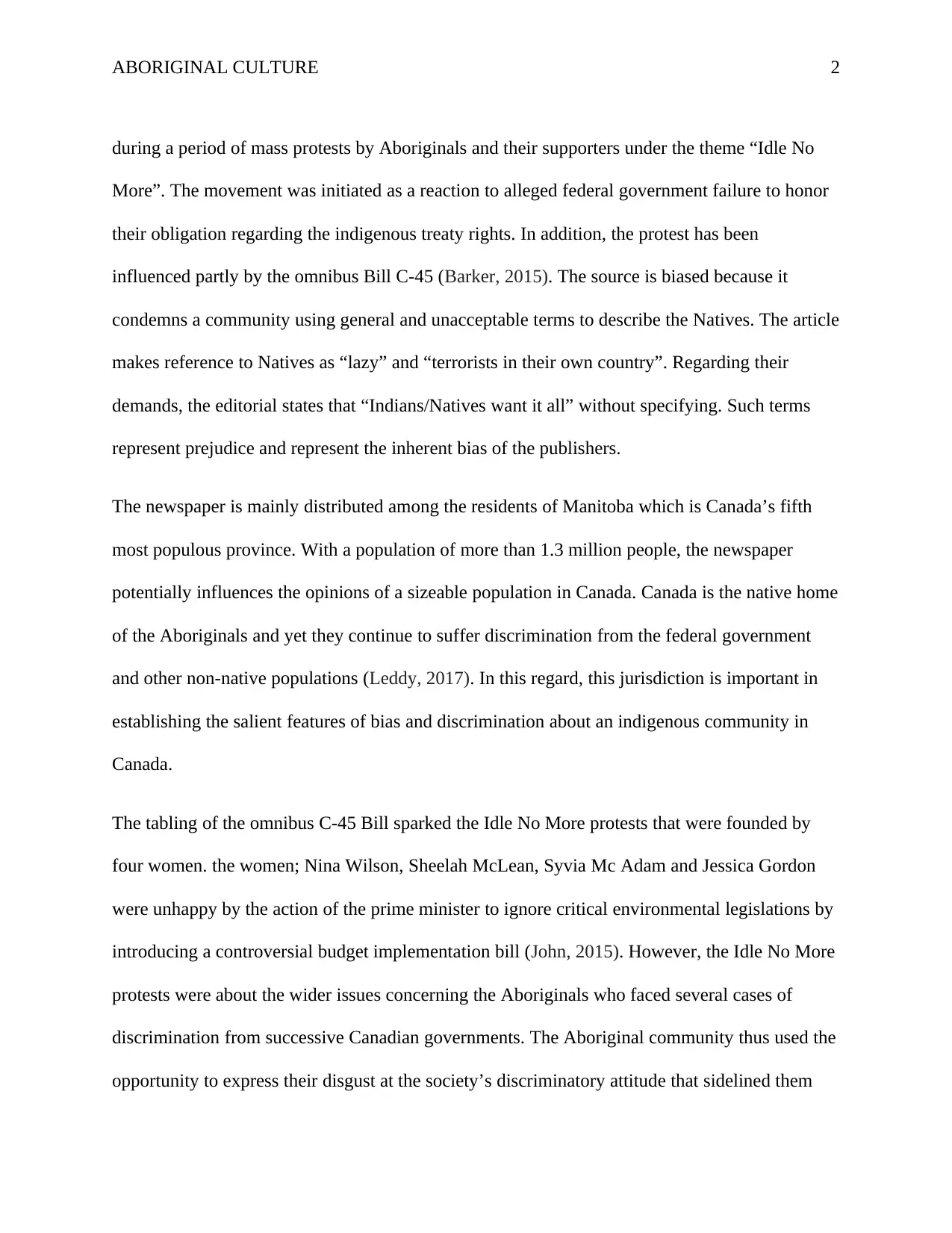
ABORIGINAL CULTURE 2
during a period of mass protests by Aboriginals and their supporters under the theme “Idle No
More”. The movement was initiated as a reaction to alleged federal government failure to honor
their obligation regarding the indigenous treaty rights. In addition, the protest has been
influenced partly by the omnibus Bill C-45 (Barker, 2015). The source is biased because it
condemns a community using general and unacceptable terms to describe the Natives. The article
makes reference to Natives as “lazy” and “terrorists in their own country”. Regarding their
demands, the editorial states that “Indians/Natives want it all” without specifying. Such terms
represent prejudice and represent the inherent bias of the publishers.
The newspaper is mainly distributed among the residents of Manitoba which is Canada’s fifth
most populous province. With a population of more than 1.3 million people, the newspaper
potentially influences the opinions of a sizeable population in Canada. Canada is the native home
of the Aboriginals and yet they continue to suffer discrimination from the federal government
and other non-native populations (Leddy, 2017). In this regard, this jurisdiction is important in
establishing the salient features of bias and discrimination about an indigenous community in
Canada.
The tabling of the omnibus C-45 Bill sparked the Idle No More protests that were founded by
four women. the women; Nina Wilson, Sheelah McLean, Syvia Mc Adam and Jessica Gordon
were unhappy by the action of the prime minister to ignore critical environmental legislations by
introducing a controversial budget implementation bill (John, 2015). However, the Idle No More
protests were about the wider issues concerning the Aboriginals who faced several cases of
discrimination from successive Canadian governments. The Aboriginal community thus used the
opportunity to express their disgust at the society’s discriminatory attitude that sidelined them
during a period of mass protests by Aboriginals and their supporters under the theme “Idle No
More”. The movement was initiated as a reaction to alleged federal government failure to honor
their obligation regarding the indigenous treaty rights. In addition, the protest has been
influenced partly by the omnibus Bill C-45 (Barker, 2015). The source is biased because it
condemns a community using general and unacceptable terms to describe the Natives. The article
makes reference to Natives as “lazy” and “terrorists in their own country”. Regarding their
demands, the editorial states that “Indians/Natives want it all” without specifying. Such terms
represent prejudice and represent the inherent bias of the publishers.
The newspaper is mainly distributed among the residents of Manitoba which is Canada’s fifth
most populous province. With a population of more than 1.3 million people, the newspaper
potentially influences the opinions of a sizeable population in Canada. Canada is the native home
of the Aboriginals and yet they continue to suffer discrimination from the federal government
and other non-native populations (Leddy, 2017). In this regard, this jurisdiction is important in
establishing the salient features of bias and discrimination about an indigenous community in
Canada.
The tabling of the omnibus C-45 Bill sparked the Idle No More protests that were founded by
four women. the women; Nina Wilson, Sheelah McLean, Syvia Mc Adam and Jessica Gordon
were unhappy by the action of the prime minister to ignore critical environmental legislations by
introducing a controversial budget implementation bill (John, 2015). However, the Idle No More
protests were about the wider issues concerning the Aboriginals who faced several cases of
discrimination from successive Canadian governments. The Aboriginal community thus used the
opportunity to express their disgust at the society’s discriminatory attitude that sidelined them
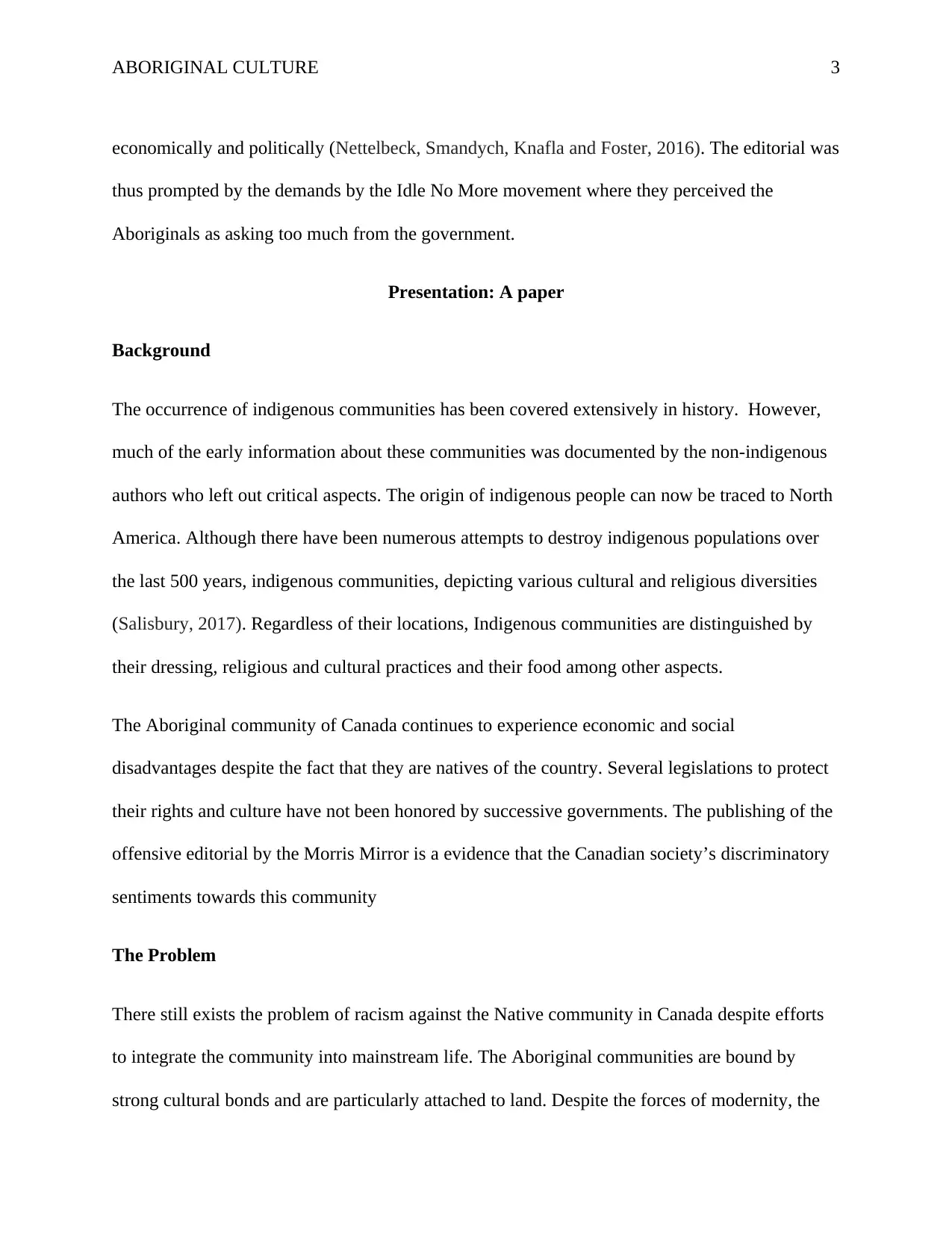
ABORIGINAL CULTURE 3
economically and politically (Nettelbeck, Smandych, Knafla and Foster, 2016). The editorial was
thus prompted by the demands by the Idle No More movement where they perceived the
Aboriginals as asking too much from the government.
Presentation: A paper
Background
The occurrence of indigenous communities has been covered extensively in history. However,
much of the early information about these communities was documented by the non-indigenous
authors who left out critical aspects. The origin of indigenous people can now be traced to North
America. Although there have been numerous attempts to destroy indigenous populations over
the last 500 years, indigenous communities, depicting various cultural and religious diversities
(Salisbury, 2017). Regardless of their locations, Indigenous communities are distinguished by
their dressing, religious and cultural practices and their food among other aspects.
The Aboriginal community of Canada continues to experience economic and social
disadvantages despite the fact that they are natives of the country. Several legislations to protect
their rights and culture have not been honored by successive governments. The publishing of the
offensive editorial by the Morris Mirror is a evidence that the Canadian society’s discriminatory
sentiments towards this community
The Problem
There still exists the problem of racism against the Native community in Canada despite efforts
to integrate the community into mainstream life. The Aboriginal communities are bound by
strong cultural bonds and are particularly attached to land. Despite the forces of modernity, the
economically and politically (Nettelbeck, Smandych, Knafla and Foster, 2016). The editorial was
thus prompted by the demands by the Idle No More movement where they perceived the
Aboriginals as asking too much from the government.
Presentation: A paper
Background
The occurrence of indigenous communities has been covered extensively in history. However,
much of the early information about these communities was documented by the non-indigenous
authors who left out critical aspects. The origin of indigenous people can now be traced to North
America. Although there have been numerous attempts to destroy indigenous populations over
the last 500 years, indigenous communities, depicting various cultural and religious diversities
(Salisbury, 2017). Regardless of their locations, Indigenous communities are distinguished by
their dressing, religious and cultural practices and their food among other aspects.
The Aboriginal community of Canada continues to experience economic and social
disadvantages despite the fact that they are natives of the country. Several legislations to protect
their rights and culture have not been honored by successive governments. The publishing of the
offensive editorial by the Morris Mirror is a evidence that the Canadian society’s discriminatory
sentiments towards this community
The Problem
There still exists the problem of racism against the Native community in Canada despite efforts
to integrate the community into mainstream life. The Aboriginal communities are bound by
strong cultural bonds and are particularly attached to land. Despite the forces of modernity, the
⊘ This is a preview!⊘
Do you want full access?
Subscribe today to unlock all pages.

Trusted by 1+ million students worldwide
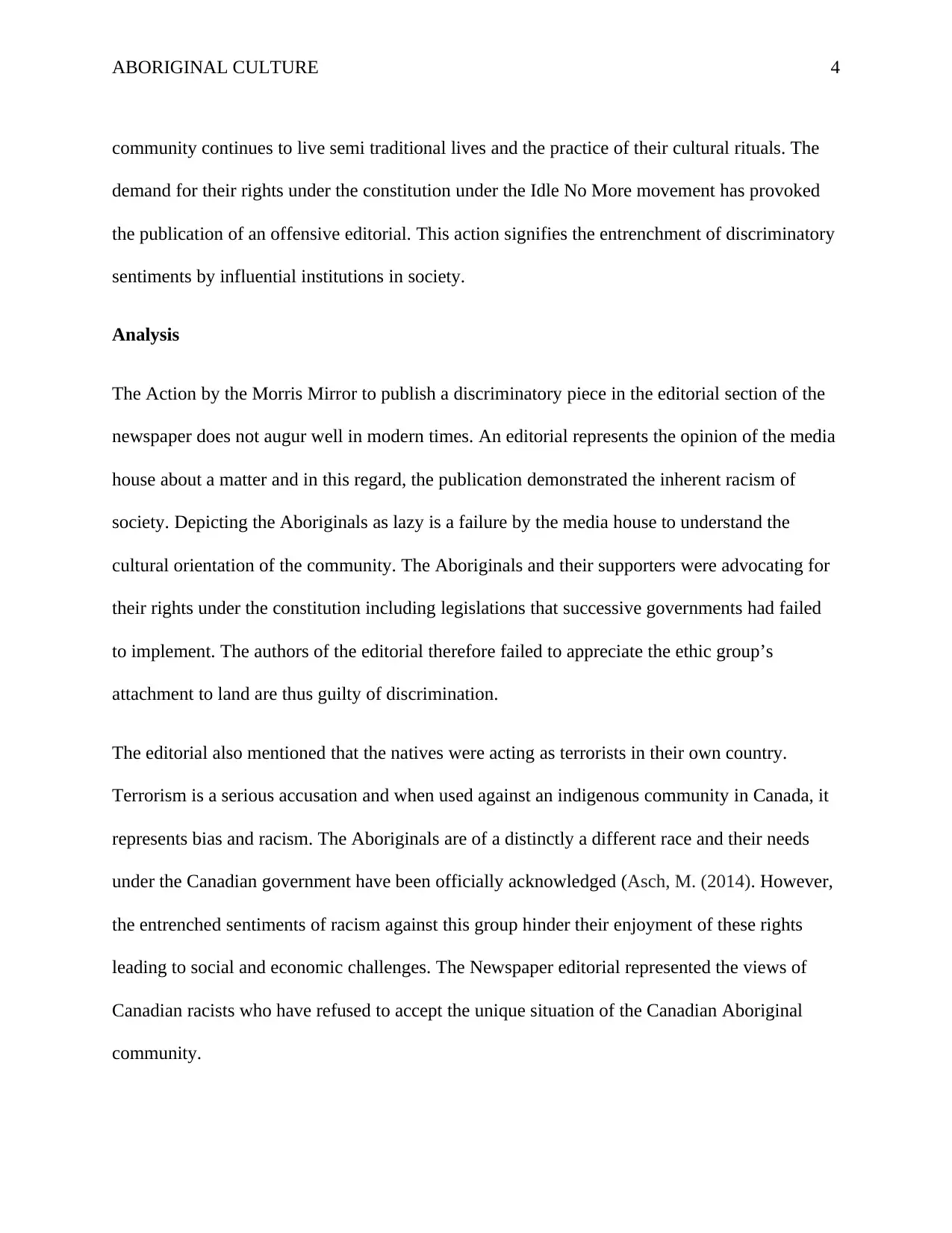
ABORIGINAL CULTURE 4
community continues to live semi traditional lives and the practice of their cultural rituals. The
demand for their rights under the constitution under the Idle No More movement has provoked
the publication of an offensive editorial. This action signifies the entrenchment of discriminatory
sentiments by influential institutions in society.
Analysis
The Action by the Morris Mirror to publish a discriminatory piece in the editorial section of the
newspaper does not augur well in modern times. An editorial represents the opinion of the media
house about a matter and in this regard, the publication demonstrated the inherent racism of
society. Depicting the Aboriginals as lazy is a failure by the media house to understand the
cultural orientation of the community. The Aboriginals and their supporters were advocating for
their rights under the constitution including legislations that successive governments had failed
to implement. The authors of the editorial therefore failed to appreciate the ethic group’s
attachment to land are thus guilty of discrimination.
The editorial also mentioned that the natives were acting as terrorists in their own country.
Terrorism is a serious accusation and when used against an indigenous community in Canada, it
represents bias and racism. The Aboriginals are of a distinctly a different race and their needs
under the Canadian government have been officially acknowledged (Asch, M. (2014). However,
the entrenched sentiments of racism against this group hinder their enjoyment of these rights
leading to social and economic challenges. The Newspaper editorial represented the views of
Canadian racists who have refused to accept the unique situation of the Canadian Aboriginal
community.
community continues to live semi traditional lives and the practice of their cultural rituals. The
demand for their rights under the constitution under the Idle No More movement has provoked
the publication of an offensive editorial. This action signifies the entrenchment of discriminatory
sentiments by influential institutions in society.
Analysis
The Action by the Morris Mirror to publish a discriminatory piece in the editorial section of the
newspaper does not augur well in modern times. An editorial represents the opinion of the media
house about a matter and in this regard, the publication demonstrated the inherent racism of
society. Depicting the Aboriginals as lazy is a failure by the media house to understand the
cultural orientation of the community. The Aboriginals and their supporters were advocating for
their rights under the constitution including legislations that successive governments had failed
to implement. The authors of the editorial therefore failed to appreciate the ethic group’s
attachment to land are thus guilty of discrimination.
The editorial also mentioned that the natives were acting as terrorists in their own country.
Terrorism is a serious accusation and when used against an indigenous community in Canada, it
represents bias and racism. The Aboriginals are of a distinctly a different race and their needs
under the Canadian government have been officially acknowledged (Asch, M. (2014). However,
the entrenched sentiments of racism against this group hinder their enjoyment of these rights
leading to social and economic challenges. The Newspaper editorial represented the views of
Canadian racists who have refused to accept the unique situation of the Canadian Aboriginal
community.
Paraphrase This Document
Need a fresh take? Get an instant paraphrase of this document with our AI Paraphraser
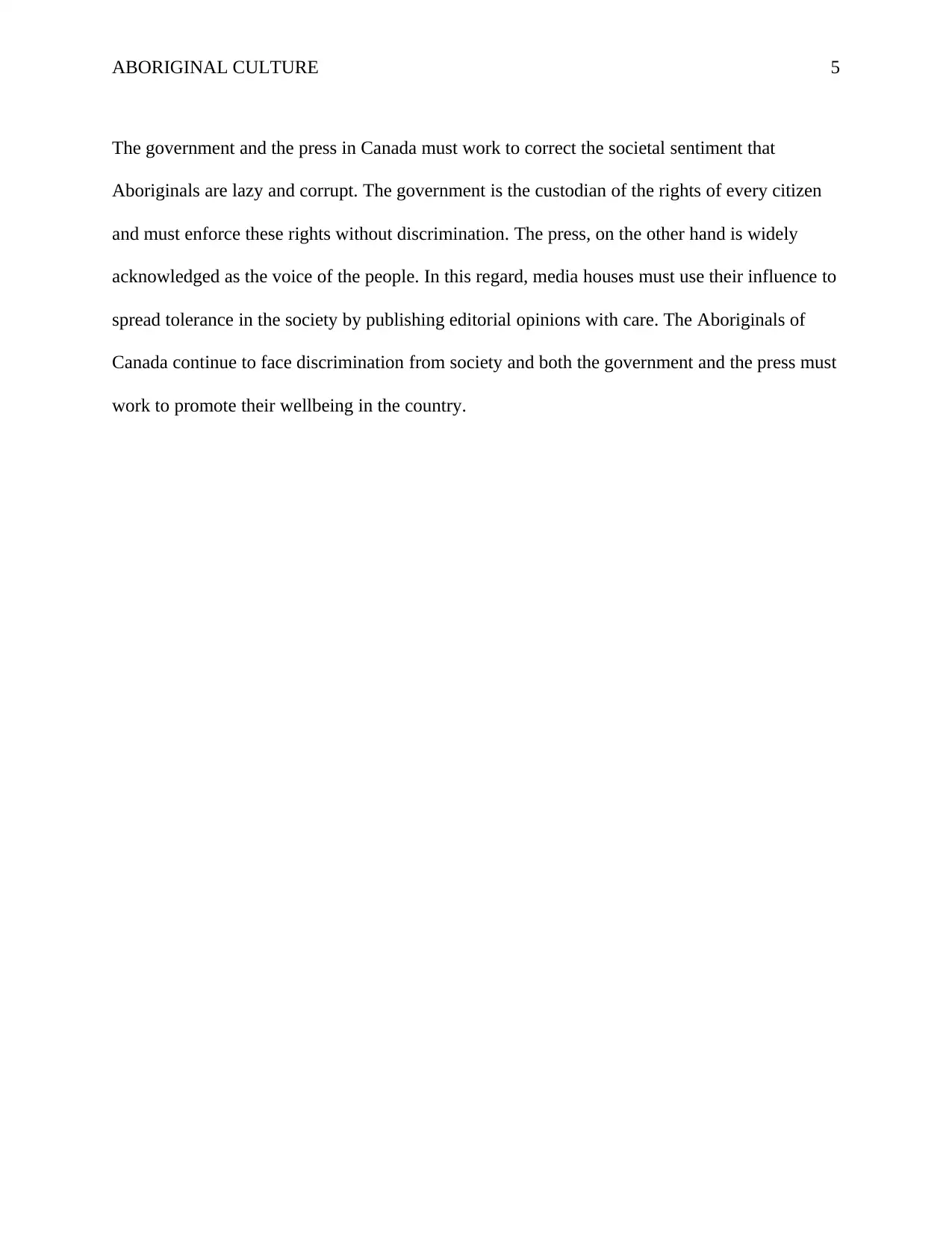
ABORIGINAL CULTURE 5
The government and the press in Canada must work to correct the societal sentiment that
Aboriginals are lazy and corrupt. The government is the custodian of the rights of every citizen
and must enforce these rights without discrimination. The press, on the other hand is widely
acknowledged as the voice of the people. In this regard, media houses must use their influence to
spread tolerance in the society by publishing editorial opinions with care. The Aboriginals of
Canada continue to face discrimination from society and both the government and the press must
work to promote their wellbeing in the country.
The government and the press in Canada must work to correct the societal sentiment that
Aboriginals are lazy and corrupt. The government is the custodian of the rights of every citizen
and must enforce these rights without discrimination. The press, on the other hand is widely
acknowledged as the voice of the people. In this regard, media houses must use their influence to
spread tolerance in the society by publishing editorial opinions with care. The Aboriginals of
Canada continue to face discrimination from society and both the government and the press must
work to promote their wellbeing in the country.
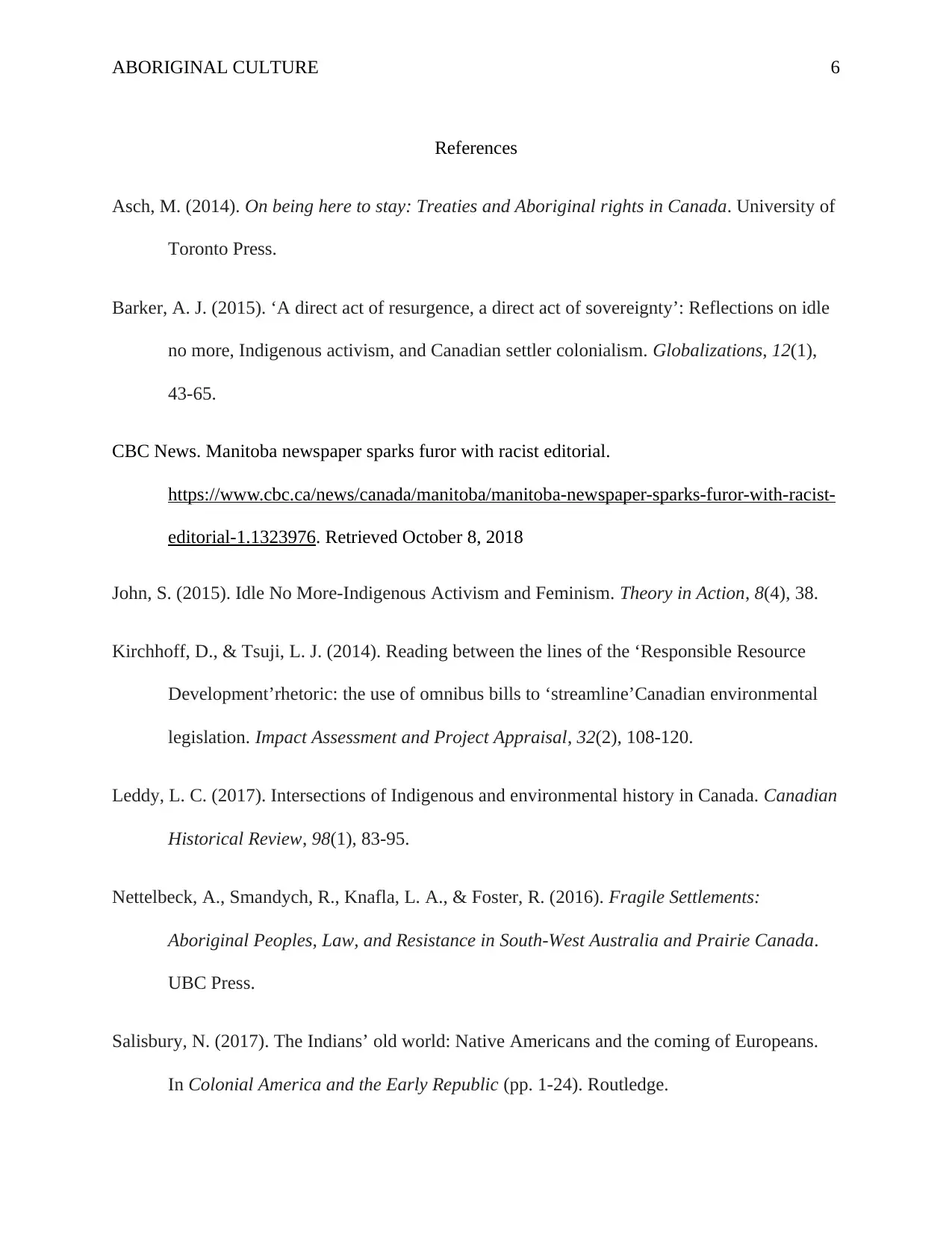
ABORIGINAL CULTURE 6
References
Asch, M. (2014). On being here to stay: Treaties and Aboriginal rights in Canada. University of
Toronto Press.
Barker, A. J. (2015). ‘A direct act of resurgence, a direct act of sovereignty’: Reflections on idle
no more, Indigenous activism, and Canadian settler colonialism. Globalizations, 12(1),
43-65.
CBC News. Manitoba newspaper sparks furor with racist editorial.
https://www.cbc.ca/news/canada/manitoba/manitoba-newspaper-sparks-furor-with-racist-
editorial-1.1323976. Retrieved October 8, 2018
John, S. (2015). Idle No More-Indigenous Activism and Feminism. Theory in Action, 8(4), 38.
Kirchhoff, D., & Tsuji, L. J. (2014). Reading between the lines of the ‘Responsible Resource
Development’rhetoric: the use of omnibus bills to ‘streamline’Canadian environmental
legislation. Impact Assessment and Project Appraisal, 32(2), 108-120.
Leddy, L. C. (2017). Intersections of Indigenous and environmental history in Canada. Canadian
Historical Review, 98(1), 83-95.
Nettelbeck, A., Smandych, R., Knafla, L. A., & Foster, R. (2016). Fragile Settlements:
Aboriginal Peoples, Law, and Resistance in South-West Australia and Prairie Canada.
UBC Press.
Salisbury, N. (2017). The Indians’ old world: Native Americans and the coming of Europeans.
In Colonial America and the Early Republic (pp. 1-24). Routledge.
References
Asch, M. (2014). On being here to stay: Treaties and Aboriginal rights in Canada. University of
Toronto Press.
Barker, A. J. (2015). ‘A direct act of resurgence, a direct act of sovereignty’: Reflections on idle
no more, Indigenous activism, and Canadian settler colonialism. Globalizations, 12(1),
43-65.
CBC News. Manitoba newspaper sparks furor with racist editorial.
https://www.cbc.ca/news/canada/manitoba/manitoba-newspaper-sparks-furor-with-racist-
editorial-1.1323976. Retrieved October 8, 2018
John, S. (2015). Idle No More-Indigenous Activism and Feminism. Theory in Action, 8(4), 38.
Kirchhoff, D., & Tsuji, L. J. (2014). Reading between the lines of the ‘Responsible Resource
Development’rhetoric: the use of omnibus bills to ‘streamline’Canadian environmental
legislation. Impact Assessment and Project Appraisal, 32(2), 108-120.
Leddy, L. C. (2017). Intersections of Indigenous and environmental history in Canada. Canadian
Historical Review, 98(1), 83-95.
Nettelbeck, A., Smandych, R., Knafla, L. A., & Foster, R. (2016). Fragile Settlements:
Aboriginal Peoples, Law, and Resistance in South-West Australia and Prairie Canada.
UBC Press.
Salisbury, N. (2017). The Indians’ old world: Native Americans and the coming of Europeans.
In Colonial America and the Early Republic (pp. 1-24). Routledge.
⊘ This is a preview!⊘
Do you want full access?
Subscribe today to unlock all pages.

Trusted by 1+ million students worldwide
1 out of 6
Your All-in-One AI-Powered Toolkit for Academic Success.
+13062052269
info@desklib.com
Available 24*7 on WhatsApp / Email
![[object Object]](/_next/static/media/star-bottom.7253800d.svg)
Unlock your academic potential
Copyright © 2020–2025 A2Z Services. All Rights Reserved. Developed and managed by ZUCOL.